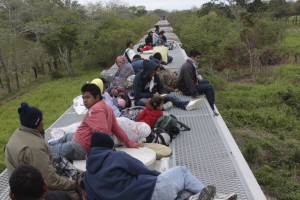
Many Central American Immigrants crossing over from Guatemala rely on freight trains to make their way toward the US (Image courtesy: Irineo Mujica)
Irineo Mujica is furious, bitter and fiercely protective of the residents at his shelter.
Mujica is a photojournalist who works with the Hermanos en el Camino, a pit stop for immigrants in the town of Ixtepec in Southern Mexico, keeping constant vigil to protect the men and women in the shelter.
Rapidly expanding drug cartels, corrupt police and angry locals have made the journey through Mexico a frightening experience for immigrants from Central America headed toward the US.
“They come into the shelter with cuts and injuries because they are beaten by those involved in organized crime,” Mujica says over the phone from Ixtepec. What makes matters worse is the complicity of the police. “There is so much corruption that instead of sending them back, the Mexican police turn them over to kidnappers,” he adds.
Despite Mexico’s criticism of U.S. immigration policy, the fate of immigrants from neighboring countries like Guatemala and El Salvador negotiating the dangerous Mexican terrain has put the spotlight on that country’s handling of immigrants.
In August, a mass grave with more than 70 bodies believed to be of Central American immigrants was discovered just south of the Texas border. In the same year, during a six-month span between April and September, more than 11,000 immigrants were kidnapped, according to Mexico’s human rights commission.
To avoid a similar fate, 513 migrants, crammed in two trucks, tried to make it across the border from Guatemala, through Mexico and to America last week. But they were apprehended by officials in the southern Mexican state of Chiapas. Numbers published by the government say more than 25,000 immigrants were intercepted by Mexican forces in 2010.
“It is not Mexico’s job to stop people from going to America,” Mujica says. “It is not our responsibility to do the dirty work for the United States.
“Should we keep giving the government the power to handle the migrants when they have completely proven that they cannot,” he says.
It’s not just the police and drug gangs that pose risks to the immigrants. Some Mexican locals are annoyed with immigrants who use Mexico to go toward America. In 2008, the shelter house in Ixtepec was attacked by a group of more than 50 local residents who suspected some of the immigrants in the shelter of being involved in neighborhood crimes.
“Our job is to make sure they are treated as human beings.” Mujica says. “You have not seen them with blood coming out of their eyes. It is not easy to understand from another country.”
Officials at the shelter say nearly 3000 immigrants take refuge at the shelter every month. They live there for a few days—eat, shower and rest—before continuing their trip toward America.
“This is a gamble with your life,” Mujica says. “Probably one of the most dangerous routes you will ever encounter.”
Mujica says there are immigrants who have been seen at the shelter more than once. “Some people will try again and again till they succeed,” he adds. “Not trying is not an option.”
One of them making another attempt is Rafael Martinez from El Salvador. He recalls his first trip to America in 1980.
CNN had just launched, the Cold War had intensified and the fate of the 52 U.S. citizens in the Iranian hostage crisis hung in balance. When everyone’s attention was focused elsewhere, Martinez says he jumped the Mexican-American border with his family and started a new life in San Fernando, California.
But a couple of run-ins with the law, the last of which was a traffic violation, led to Martinez being deported in 2001. He made another attempt to return to America from El Salvador the next year—this time around, he didn’t get far.
“I got shot in the back,” he says, describing the time when he got caught in crossfire in Southern Mexico. He was admitted into a local hospital and soon after sent back to El Salvador.
After nine years he is making another attempt to reunite with his family. His seven children, he says, were born in America and are still living here. The most important reason that kept him from trying to get back, he says, was the fear of getting shot again.
The fear is still there. “There are people kidnapping and killing on the way,” he says, referring to the dual risk from criminal syndicates and the corrupt police.
The activists at the shelter are trying to help him get an official permit to get back to his family in California. Martinez doesn’t know how far he will get but he promises not to stall his efforts midway.
“I have been away from my kids for 11 years now,” he says. “If I die trying to see them again, it doesn’t matter to me anymore.”





